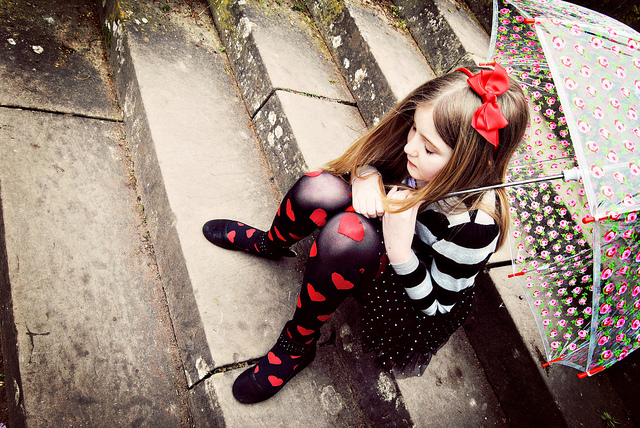I have a wonderfully determined, opinionated 6-year-old daughter.
She creates cards, drawings, paintings, elaborate outfits and amusing games. Her wild and imaginative mind is a great strength, but it is sometimes her downfall. She believes scenarios like—I don’t love her anymore, simply because I want her to get ready for bed, or that she is the cause of great unhappiness, after seeing her dad’s concern over her latest boo-boo.
Sometimes she lashes out at her father and I in frustration—usually over not wanting to be helped, taught or shown a new way of doing something. She has a story in her head about accepting help or guidance. Perhaps she feels patronized. I certainly don’t want to discourage her, but I do want her to be open to growth and learning.
Often we let things go—okay, she doesn’t want to hear it. She can keep doing the math on her fingers, until she figures out another way or someone else teachers her—not mom or dad.
But there is something that I feel I need to impart to her—something that I will not let go of trying to teach. What I want her to know is that feelings are okay. They are meant to inform us, then proceed to move through us. Feeling all the way through is a path to freedom and restored peace.
I wish for her to know her center and core being—the energy that resides always in her heart and the peace that passeth all understanding.
Her process right now—this not wanting to be taught things by mom—makes the teaching process exceedingly difficult. I suggest a practice, and she covers her ears.
Though met with resistance, I rely on the foundation I laid when she was not yet two. I taught her deep breathing. We designated a small bean-bag as her “peace chair,” where she can sit, breathe and regain her calm.
She would go on her own sometimes, she was escorted there many times, and then started to bring her stuffed friends there whilst giving them instruction. She—admittedly like me—a more willing teacher than student.
The teachable moments now come when she is desperate. This past summer, she developed an unbearable sensitivity to wet hair touching her back. This was inconvenient as we had just signed up for swimming lessons, and it was summer. After many days and nights of crying and squirming tantrums over wet hair, she agreed to try an idea that I had.
I set up meditation cushions and sprayed the ends of her hair with water. She took off her shirt, I wrapped her in a towel and we sat down. Her shoulders were scrunched up toward her ears as she alternated whining and holding her breath. I instructed her to close her eyes, and tell me exactly what it felt like on her back.
“It’s kind of cold,” she said.
I encouraged her to breathe and keep feeling it. Her shoulders relaxed, and her breathing smoothed out after a minute or two.
“It’s not that bad,” she said.
She opened her eyes. We laughed, and she was suddenly proud of being able to stand wet hair on her back. From then on she requested I leave the ends wet after her showers.
In another recent outburst of frustration toward me while playing a game, I suggested we try to feel and breathe. She resisted.
She sat down to dinner, still crying.
“Okay, let’s do it,” she said.
It took only a minute for her to identify a “bumpy” feeling in the middle of her chest and to notice it smooth out as she breathed.
I only coached her to feel it and to allow it space to be there. Once it felt smooth, she was back, and we had a nice dinner.
I try to practice this myself as well. This morning I sank into despair over the statistics around mass shootings in America. My thoughts and opinions swirled into a frustrating mass that created heaviness in my chest. I cried. “What can I do? What should I do?” The helplessness was debilitating.
I sat and felt. I surrendered my questions and thoughts to spirit for a moment—though I’ll be sure to take them back later—I know me. I found that what was left was that smoothness, calm and peace.
What if all we knew was that peace? What if everyone could drop below the cacophony of the mind—disbelieve everything for a moment and feel?
I propose that we would laugh. We would love and take inspired action.
Okay, maybe not everyone would be able to do it or get there—but I think the majority of humans have this capacity. Many of us are not trying or have not been taught. Some are just like my 6-year-old and don’t want to be taught.
The Dalai Lama said: “If every 8-year-old in the world is taught meditation, we will eliminate violence from the world within one generation.”
I know it’s a highly contested statement, but I have no interest in debating it. Why don’t we just try it out, and see if it’s true? (Wink, wink.)
In the meantime, I will continue trying to eliminate violence from my mind and from my home. I will continue to teach meditation—residing in the true ground of being—moments at a time.
This lesson, I will continue to share with my daughter, children at my Sunday services, yoga students and anyone who asks to be shown the way to moments of peace within.
Those who reside in that peaceful place will turn the tide of this country and the world toward peace. Surely we are desperate enough—have cried enough and are tired enough of violence—to try another way.
.
Relephant:
5 Tips for Raising Radiant Kids.
How Moms can Make Time for Meditation.
Author: Lisa Sarick
Apprentice Editor: Danica Taylor/Editor: Yoli Ramazzina
Photo: Flickr/Lauren Hammond







Read 0 comments and reply